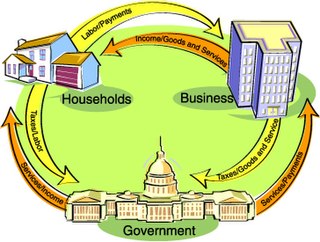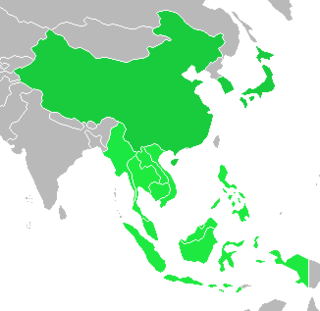Special drawing rights (SDRs) are supplementary foreign exchange reserve assets defined and maintained by the International Monetary Fund (IMF). SDRs are units of account for the IMF, and not a currency per se. They represent a claim to currency held by IMF member countries for which they may be exchanged. SDRs were created in 1969 to supplement a shortfall of preferred foreign exchange reserve assets, namely gold and U.S. dollars. The ISO 4217 currency code for special drawing rights is XDR and the numeric code is 960.

The Association of Southeast Asian Nations is a regional intergovernmental organization comprising ten countries in Southeast Asia, which promotes intergovernmental cooperation and facilitates economic, political, security, military, educational, and sociocultural integration among its members and other countries in Asia. ASEAN primarily objective was to accelerate economic growth and through that social progress and cultural development. A Secondary objective was to promote regional peace and stability based on the rule of law and the principle of United Nations charter. Whether some of the fastest growing economy is in the world asean broadened its objective beyond the economic and social spheres. In 2003, ASEAN moved along the path of EU by agreeing to establish an Asean community comprising three pillars namely the ASEAN security community the ASEAN economic community and the ASEAN socio -cultural community. In the asean logo the ten stalks (rice) represent the ten southeast Asian countries bound together in friendship and solidarity, the circle symbolises the unity of ASEAN

The Asia-Pacific Economic Cooperation is an inter-governmental forum for 21 member economies in the Pacific Rim that promotes free trade throughout the Asia-Pacific region. Following the success of ASEAN's series of post-ministerial conferences launched in the mid-1980s, APEC started in 1989, in response to the growing interdependence of Asia-Pacific economies and the advent of regional trade blocs in other parts of the world; it aimed to establish new markets for agricultural products and raw materials beyond Europe. Headquartered in Singapore, APEC is recognized as one of the highest-level multilateral blocs and oldest forums in the Asia-Pacific region, and exerts a significant global influence.

In macroeconomics, the money supply is the total value of money available in an economy at a point of time. There are several ways to define "money", but standard measures usually include currency in circulation and demand deposits. The central bank of each country may use a definition of what constitutes money for its purposes.

In finance, an exchange rate is the rate at which one currency will be exchanged for another. It is also regarded as the value of one country's currency in relation to another currency. For example, an interbank exchange rate of 114 Japanese yen to the United States dollar means that ¥114 will be exchanged for US$1 or that US$1 will be exchanged for ¥114. In this case it is said that the price of a dollar in relation to yen is ¥114, or equivalently that the price of a yen in relation to dollars is $1/114.

The Asian financial crisis was a period of financial crisis that gripped much of East Asia and Southeast Asia beginning in July 1997 and raised fears of a worldwide economic meltdown due to financial contagion.
The foreign exchange market is a global decentralized or over-the-counter (OTC) market for the trading of currencies. This market determines foreign exchange rates for every currency. It includes all aspects of buying, selling and exchanging currencies at current or determined prices. In terms of trading volume, it is by far the largest market in the world, followed by the credit market.
The economy of Asia comprises more than 4.5 billion people living in 49 different nations. Asia is the fastest growing economic region, as well as the largest continental economy by both GDP Nominal and PPP in the world. Moreover, Asia is the site of some of the world's longest modern economic booms, starting from the Japanese economic miracle (1950–1990), Miracle on the Han River (1961–1996) in South Korea, economic boom (1978–2013) in China, Tiger Cub Economies (1990–present) in Indonesia, Malaysia, Thailand, Philippines, and Vietnam, and economic boom in India (1991–present).

The East Asia Summit (EAS) is a regional forum held annually by leaders of, initially, 16 countries in the East Asian, Southeast Asian, South Asian and Oceanian regions, based on the ASEAN Plus Six mechanism. Membership expanded to 18 countries including Russia and the United States at the Sixth EAS in 2011. Since its establishment, ASEAN has held the central role and leadership in the forum. EAS meetings are held after the annual ASEAN leaders' meetings, and plays an important role in the regional architecture of Asia-Pacific. The first summit was held in Kuala Lumpur, Malaysia on 14 December 2005.
The East Asia Economic Caucus (EAEC) or East Asia Economic Group (EAEG) was a regional free trade zone (FTA) proposed in 1997 by Malaysian Prime Minister Dr. Mahathir bin Mohamad and encompasses the Association of Southeast Asian Nations (ASEAN) member states, China, Japan, and the Republic of Korea. Japan though refused participation due to the exclusion of the Western nations, which were already members of APEC and many other notable regional organizations in East Asia.
East Asian Community (EAC) is a proposed trade bloc for the East Asian and Southeast Asian countries that may arise out of either ASEAN Plus Three or the East Asia Summit (EAS).
The East Asia Summit (EAS) is a pan-Asia forum held annually by the leaders of 16 countries in the East Asian region. EAS meetings are held after annual ASEAN leaders' meetings.
The East Asia Summit (EAS) is a pan-Asia forum held annually by the leaders of 16 countries in the East Asian region. EAS meetings are held after annual ASEAN leaders' meetings.

The Economic Research Institute for ASEAN and East Asia or ERIA is an international organization established in Jakarta, Indonesia in 2008 by a formal agreement among Leaders of 16 countries in the East Asian region to conduct research activities and make policy recommendations for further economic integration in the East Asia. ERIA works very closely with both the ASEAN Secretariat and 16 Research Institutes to undertake and disseminate policy research under the three pillars, namely “Deepening Economic Integration”, ”Narrowing Development Gaps”, and “Sustainable Development” and provide analytical policy recommendations to Leaders and Ministers at their regional meetings. ERIA provides intellectual contributions to East Asian Community building and serves as a Sherpa international organization. ERIA ranks 32nd among the world's "Top 85 International Economics Think Tanks" according to the 2016 Global Go To Think Tanks Index Report conducted by University of Pennsylvania.

The Chiang Mai Initiative (CMI) is a multilateral currency swap arrangement among the ten members of the Association of Southeast Asian Nations (ASEAN), the People's Republic of China, Japan, and South Korea. It draws from a foreign exchange reserves pool worth US$120 billion and was launched on 24 March 2010. That pool has been expanded to $240 billion in 2012.
A fixed exchange rate, sometimes called a pegged exchange rate, is a type of exchange rate regime in which a currency's value is fixed or pegged by a monetary authority against the value of another currency, a basket of other currencies, or another measure of value, such as gold.
Central bank liquidity swap is a type of currency swap used by a country's central bank to provide liquidity of its currency to another country's central bank. In a liquidity swap, the lending central bank uses its currency to buy the currency of another borrowing central bank at the market exchange rate, and agrees to sell the borrower's currency back at a rate that reflects the interest accrued on the loan. The borrower's currency serves as collateral.
The Comprehensive Economic Partnership for East Asia (CEPEA) is a Japanese led proposal for trade co-operation, free trade agreement, among the 16 present member countries of the East Asia Summit. All those movements and efforts were taken over by the following Regional Comprehensive Economic Partnership.

The Regional Comprehensive Economic Partnership is a free trade agreement initiated by Indonesia, between the Asia-Pacific nations of Australia, Brunei, Cambodia, China, Indonesia, Japan, Laos, Malaysia, Myanmar, New Zealand, the Philippines, Singapore, South Korea, Thailand, and Vietnam. The 15 member countries account for about 30% of the world's population and 30% of global GDP as of 2020, making it the biggest trade bloc in history. Unifying the preexisting bilateral agreements between the 10-member ASEAN and five of its major trade partners, the RCEP was signed on 15 November 2020 at a virtual ASEAN Summit hosted by Vietnam, and will take effect 60 days after it has been ratified by at least six ASEAN and three non-ASEAN signatories.








